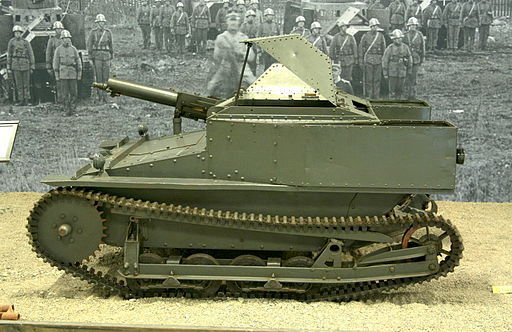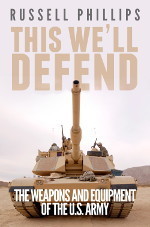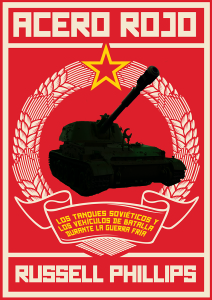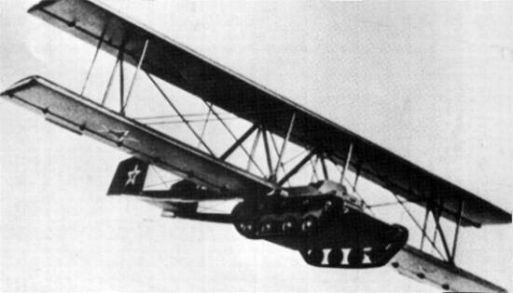Russell Phillips's Blog, page 14
October 23, 2014
Self-Printed 3.0 Splash: Essential WordPress Plug-ins
Catherine Ryan Howard is a self-published author and blogger. When I first started thinking about self-publishing, her blog helped get me up to speed. She’s also written a book on the subject, the third edition of which is now available. Since she’s given me so much help and advice, I decided to take part in the Self-Printed 3.0 splash, to help her launch her new book (and, yes, the chance to win a prize helped).
I asked, “What WordPress plug-ins are absolutely essential for an author website/blog?” Her answer is below:
Catherine’s Answer
Well, here’s the thing Russell: I don’t use WordPress.org, so I don’t use plug-ins. (For those of you who don’t know the difference between WordPress.org and WordPress.com, the first is the self-hosted one you have to pay for and the second is the free one you don’t.) I have never paid for anything to do with my website – or, to be more specific, the blog I make look like my website – except for the €18 a year or something for the URL upgrade which allows me to take “wordpress” out of my website name, i.e. www.catherineryanhoward.com. I absolutely adore WordPress.com and think they have everything you need to make a great blog and/or website, and that since self-publishers should be trying to save money where they can, that’s what I’d recommend other self-publishers use. Bonus: you also don’t have to worry about plug-ins!
If we’re talking the features of an author website/blog, I’d say keep it simple, functional and professional. You’d want a section all about your books, obviously, plus an “About” page, plus a way for people to contact you in private (a “Contact” page with either your e-mail address or a contact form, which you can easily insert in WordPress.com). Telling people they can get you via Twitter is not acceptable; you never know who might be trying to get a hold of you and chances are, one day it’ll be someone who doesn’t want to have to do it in public, like a radio show producer or a publisher. A newsletter sign-up and links to your other online homes (Twitter, Facebook, etc.) is essential. I’m against having fifty different flashing widgets in your sidebar just because if you paid to have your website professionally designed, the design wouldn’t come back looking like that. Cohesiveness is best. Above all else, don’t distract from the content.
About Catherine
Catherine Ryan Howard is a writer, self-publisher and caffeine enthusiast from Cork, Ireland. SELF-PRINTED: THE SANE PERSON’S GUIDE TO SELF-PUBLISHING (3rd edition) is out now in paperback and e-book and available from Amazon. Follow the #selfprintedsplash on Twitter today (Friday 24th) and/or visit www.catherineryanhoward.com for the chance to win an amazing prize that will get your self-publishing adventure started!
“SELF-PRINTED is my self-publishing bible. It taught me how to format, create and upload my e-books and print-on-demand paperbacks. It showed me practical things such as how to build a website/blog and how to promote my books. More importantly, it taught me how to compete with the professionals. Just look at the results – The Estate Series has sold nearly 100,000 copies and following that I got a traditional book deal with Thomas & Mercer too, so I’m now a hybrid author. Jam-packed full of hints and tips all in one place, I’m always referring back to it. In a word, it’s priceless.” – Mel Sherratt, author of The Estate Series and DS Allie Shenton Series.
The post Self-Printed 3.0 Splash: Essential WordPress Plug-ins appeared first on Russell Phillips.
October 20, 2014
AFV Alphabet: C is for Carden Loyd tankette
The term “Carden Loyd tankette” actually refers to a series of vehicles which were developed in the inter-war years. The Mark VI was the most successful, being built under licence in many countries.
In 1925, Carden-Loyd Tractors Ltd, a company owned by Sir John Carden and Vivian Loyd, created the Carden-Loyd One-Man Tankette. The idea was developed, and from the Mark IV onwards, became a two-man vehicle. The vehicles showed enough promise that Vickers bought Carden-Loyd Tractors in 1928. The Mark VI tankette became a great success, with over 300 seeing service in the British army, and more sold abroad. In the British army, the tankette saw service primarily as a machine gun carrier, but it was also used as a light gun tractor and mortar carrier.
It later formed the basis of the British Universal Carrier. Several other countries used it as a basis for development of their own tankette designs. Five Dutch Carden Loyd tankettes saw action in Crete, fighting German paratroopers in May 1940.
The post AFV Alphabet: C is for Carden Loyd tankette appeared first on Russell Phillips.
October 13, 2014
Pink is for Girls (and the SAS, Spitfire pilots…)
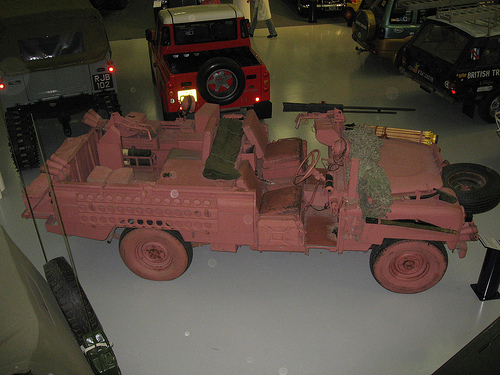
A “Pink Panther” Land Rover – not just for girls
Recently, I mentioned my AFV Alphabet series of posts to my wife and son, and they asked what I was going to write about next. My reply, “The Carden Loyd tankette”, confused my wife. Thinking she hadn’t heard correctly, I repeated the “Carden Loyd”, but apparently it was the “tankette” label that confused her. As she pointed out, the -ette suffix tends to mean feminine as well as diminutive, and has connotations of soft and fluffy. “It sounds like it should be bright pink, possibly with a bow on top”, said my wife. The Carden Loyd tankette is small, but it’s neither soft nor fluffy. It’s a serious military machine.
This got me thinking. I have a six-year old son and a two-year old daughter. My wife and I are constantly frustrated that the whole world seems to think that our daughter should wear bright pink dresses and play with dolls and toy kitchens, while our son should wear blue and play with trains and cars. Both children play with all those things, and if they enjoy them, why shouldn’t they? Why should pink be a girl’s colour and blue a boy’s colour? When she grows up, my daughter will be able to get a job driving a train, a heavy goods vehicle, or an attack helicopter, so why shouldn’t she play with the toy versions of those things? Equally, my son could become a chef, a nurse, or a care worker, so why not play with dolls and toy kitchens?.
The idea that pink is only suitable for girls is ridiculous, and this becomes even more obvious when you look at the use of the colour pink in the military. Back in WWII, some low-altitude photo reconnassance Spitfires were painted pink. Apparently it provides effective camouflage against cloud, and given the hazardous nature of the mission, anything that helped the pilot survive was a good thing. Until the 1980s, when the SAS operated in the desert, they painted their Land Rovers pink (they’re still known as “Pink Panthers”, even though the colour scheme has changed), because it was considered an effective camouflage colour. These same Land Rovers bristled with machine guns. Pink or not, there is nothing soft or fluffy about a Pink Panther Land Rover.
Photo: Army pink land rover by Paul brown, via Flickr (CC-BY-SA)
The post Pink is for Girls (and the SAS, Spitfire pilots…) appeared first on Russell Phillips.
October 6, 2014
AFV Alphabet: B is for Bishop
During the western desert campaign in the early part of World War II, the British were impressed by the German self-propelled guns, and decided that they needed something similar. A requirement was issued for a self-propelled 25 pounder gun-howitzer. By August 1941 a prototype was ready, which had a simple boxy superstructure on top of a Valentine tank chassis. An order was placed for 100 vehicles, although the vehicle didn’t impress crews in theatre. The superstructure was very large, making it an obvious target, and the gun had limited elevation, limiting its range to about half that of the towed version. The choice of an infantry tank hull meant that it was also rather slow.
No further orders were placed, and all the existing vehicles were replaced with M7 Priests and Sextons as they became available. Despite its limitations, the Bishop did provide a useful capability to the British in North Africa in the period before better self-propelled guns were available.
Photograph: Number 17430 from the collections of the Imperial War Museums. Licensed under Public domain via Wikimedia Commons.
The post AFV Alphabet: B is for Bishop appeared first on Russell Phillips.
September 29, 2014
Large Print, Free Books, Translations
I have several news items to pass on.
A Damn Close-Run Thing is now available in large print. This is something of an experiment – if sales figures suggest that large print is in demand, then I’ll look at making other books available in that format. If you would like to see one of my other books available in large print, email me and let me know.
This We’ll Defend is now available for free from most vendors (and direct from this website).
A Fleet in Being is now available in Portuguese, and will be available in German soon. Red Steel is now available in Spanish. I’ve set up a new mailing list for announcements of translations. If you are interested in translations, you can sign up at www.rpbook.co.uk/tr-list.
The post Large Print, Free Books, Translations appeared first on Russell Phillips.
September 22, 2014
AFV Alphabet: A is for Antonov A-40
Inspired by Tim Gow’s A to Z of Wargaming series of posts, I’ve decided to do an A to Z series of blog posts around the theme of AFVs (Armoured Fighting Vehicles). Hopefully I’ll be able to find some interesting subjects.
I think it’s fair to say that the Antonov A-40 flying tank qualifies as interesting. Airborne troops can be vulnerable, because they can’t use heavy support weapons or vehicles. The A-40 was an attempt to address this problem, and provide them with some armoured support. The Soviet Union had previously experimented with dropping vehicles by parachute, but was not satisfied with this method, since the crews had to be dropped separately, and may land some distance from their vehicle.
The A-40 was a T-60 light tank with the addition of glider wings, fuselage and tail. Only one flight was attempted, in September 1942, during which the towing aircraft had to release the glider early, due to excessive drag. The glider was flown down to the ground without any problems, and after removing the glider attachments, the tank was driven back to base. Although the tank did fly and land safely, the idea was dropped. Eventually, the Soviet Union managed to perfect dropping BMDs by parachute with their crews inside.
The post AFV Alphabet: A is for Antonov A-40 appeared first on Russell Phillips.
September 2, 2014
Save Up To 40% With These Bundles

My publishing company, Shilka Publishing, has set up two bundles on Wargame Vault (they aren’t available anywhere else). The bundles represent savings of 33-40%, compared to buying the individual items.
The bundles are:
Wargaming the Cold War (£3.00, usual price £4.51). Includes:
Red Steel: Soviet Tanks and Combat Vehicles of the Cold War
The Bear Marches West: 12 Scenarios for 1980s NATO vs Warsaw Pact Wargames
WWI Wargaming (£3.96, usual price £6.71). Includes:
The SOTCW World War I Compendium
Germany’s High Sea Fleet in the World War
A Fleet in Being: Austro-Hungarian Warships of WWI
The post Save Up To 40% With These Bundles appeared first on Russell Phillips.
August 4, 2014
Lights Out

“The lamps are going out all over Europe, we shall not see them lit again in our lifetime.”
The above words were spoken by Sir Edward Grey, the Foreign Secretary, as World War I began, 100 years ago.
The Royal British Legion is asking everyone in the UK to turn off their lights between 10pm and 11pm tonight, leaving a single light or candle lit, as a mark of remembrance.
The hope is to light one million candles. That’s one for every serviceman and woman who gave their life in the Great War.
My wife and I will be extinguishing our lights tonight and lighting a candle. Please join us.
For more information, see the Royal British Legion page.
The post Lights Out appeared first on Russell Phillips.
July 30, 2014
Getting The Words Down – The Writing Path Blog Tour
Andrew Knighton invited me to take part in IC Publishing‘s writing path blog tour. I try not to post too much about writing, since that isn’t really the focus of this blog, but I thought it might make an entertaining diversion. Here goes…
How do you start your writing projects?
Since I write non-fiction, I write about subjects that I’m interested in. The difficult part is choosing the next subject, since I have a lot of topics that I want to write about.
I normally write out the chapter headers first, and they serve as an outline. Normally I have a good knowledge of the subject to start with, but more research is always necessary. This can involve requests under the Freedom of Information Act, visits to the National Archives, or searching archival websites such as the Margaret Thatcher Foundation. Wherever possible I store the research in digital form, because I find it easier to organise digital files, and I can make sure I have good backups.
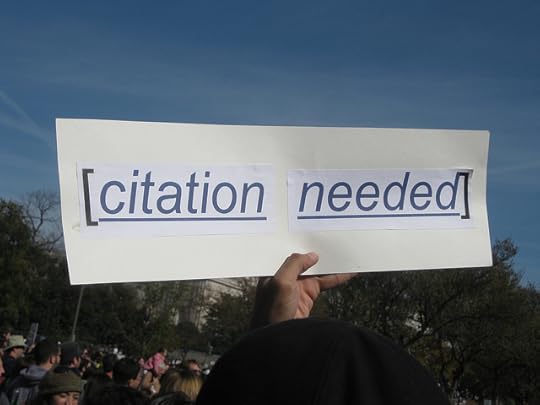
By futureatlas.com (CC-BY)
I’ve tried various tools for doing the writing. Many people rave about Scrivener, but I didn’t get on with it, possibly because I use Linux, and the Linux version is still in beta. I’ve tried writing in a text editor, using HTML or Markdown. Currently I’m writing in LibreOffice, which seems to be the best fit for me. I’ve also tried various ways of organising my research. I used Zotero for a while, but at the moment I’m using Referencer.
How do you continue your writing projects?
If I’m honest, with difficulty. I find it much easier if I can keep up momentum, so try to find time to write frequently and often. Other commitments make that difficult sometimes, but I generally manage at least one evening a week. If I have a break, I have to really force myself to sit down and write. Once I’ve done that, though, I find it easier to get back into the routine of writing (until the next break).
Sometimes I find that starting a second book helps. It gives me a break from the first book, but it keeps me writing.
How do you finish your project?
When I start the project, I have a good idea in my head of what I want to cover, so it’s easy to know when it’s complete. Then, of course, it needs to be edited. I’m gradually building up a list of regular expressions that I can use to find errors that I tend to fall for (missing Oxford commas, for instance). Once it’s as good as I can make it, I send it to my editor, Alexis at Word Vagabond. Meanwhile, I contact Kit Foster to get a cover, and try to write a description, before contacting The Blurb Doctor for help.
Give one tip that our collective communities could benefit from.
When you’ve finished editing and proof-reading, use text-to-speech software to listen to your book. The computer will read exactly what is written, which will help find some errors and typos that your eyes skip over. I often use the text-to-speech function on my Kindle, but there is software available for phones and PCs, too.
Passing the
Next week, Larry Jeram-Croft is going to continue the tour. Larry is a retired Royal Navy pilot and aircraft engineer. After thirty years service and another seven years in industry, he turned to writing. Following the principle of “writing about what you know”, he has created a series of adventure stories about the modern navy as well as two about sailing, another of his lifelong hobbies.
The post Getting The Words Down – The Writing Path Blog Tour appeared first on Russell Phillips.
July 14, 2014
Translations Now Available


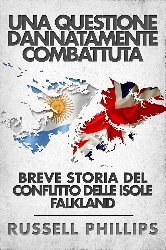
I’m starting to get my books translated into other languages. At the moment, A Damn Close-Run Thing has been translated into Italian and Spanish, and A Fleet In Being has been translated into Italian. More translations will be released soon. All translations can be found on the Translations page.
The post Translations Now Available appeared first on Russell Phillips.


